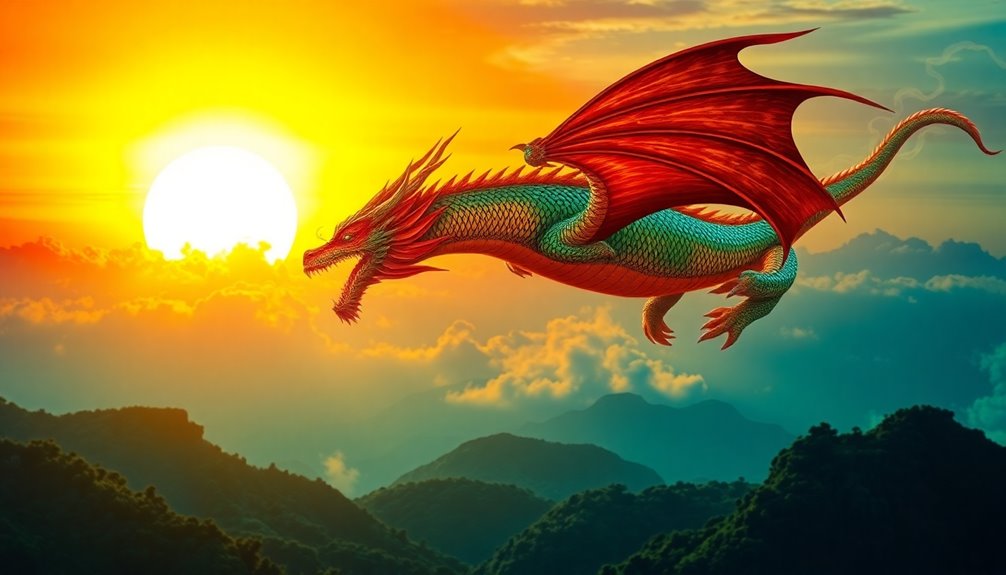Yes, symbolism is a type of figurative language! It helps writers communicate deeper meanings by using objects, characters, or colors to represent bigger ideas. For example, the green light in *The Great Gatsby* stands for unattainable dreams, making the story richer and more engaging. When you spot symbols, it invites you to think about emotions and themes in a new way. Just like imagery, symbolism adds layers to stories, connecting you with the characters. So, next time you come across a symbol, remember it's there for a reason, and there's so much more to discover about its meaning!
Key Takeaways
- Symbolism is a form of figurative language that conveys complex ideas and emotions through representative elements.
- It allows authors to embed deeper meanings within their narratives, enhancing reader engagement and understanding.
- Symbolism works alongside imagery to create rich storytelling, evoking emotions and provoking thought.
- Common symbols, such as colors or objects, can represent broader themes and concepts in literature.
- Analyzing symbolism reveals hidden messages and adds layers to the reading experience, enriching interpretation.
Understanding Symbolism in Literature

Symbolism in literature adds depth and richness to narratives, inviting you to explore deeper meanings beyond the surface. This literary device is used to represent something greater than itself, often carrying both literal and figurative meanings.
When you read a story, keep an eye out for symbols! They can be colors, animals, or even everyday objects that have special meanings. For example, a red rose might symbolize love, while a stormy sky could represent trouble ahead.
These symbols help create connections between characters and larger themes without the need for a long explanation. They evoke emotions and provoke thought, making your reading experience much more engaging.
When you recognize and analyze the symbolism in a text, you reveal hidden messages that can deepen your understanding of the author's intent.
Think of it as a treasure hunt, where each symbol you discover adds another layer to the story. So, the next time you read, remember to look for these magical symbols! They're not just words on a page; they're keys to understanding the greater meaning behind the story.
Happy reading!
Symbolism as a Figurative Language

Using symbols in literature allows authors to convey complex ideas and emotions without lengthy explanations. When writers use pieces of symbolism, they incorporate symbols—like a heart for love or a black cat for bad luck—that carry deeper meanings. This symbolic meaning invites you, the reader, to immerse yourself in the story.
Symbolism is a powerful form of figurative language that helps enhance the emotional impact of a story. Unlike direct statements, it relies on your ability to infer meanings, making you think critically about the text. Imagine a main character standing by a river; the flowing water could symbolize change and new beginnings.
This is a great example of how imagery often works hand in hand with symbolism to create rich storytelling.
Writers frequently use symbolism alongside other figurative language forms, like metaphor and simile, to add layers to their narratives. Each symbol acts as a clue, guiding you through the story elements and enriching your understanding.
Examples of Symbolism in Texts

Literature is rich with examples of symbolism that deepen the reader's experience and understanding of the narrative. One exciting first example is the green light in *The Great Gatsby*. It symbolizes Gatsby's unattainable dreams and the elusive American Dream. This type of symbolism is used to communicate deep feelings and desires.
In *To Kill a Mockingbird*, the mockingbird represents innocence. It reminds us to protect those who mean no harm, like Tom Robinson and Boo Radley.
Meanwhile, in *Animal Farm*, Napoleon the pig symbolizes the corrupting influence of power. This shows how ideals can be betrayed when power is misused.
In *Lord of the Flies*, the conch shell serves as a powerful symbol of civilization and order. When it's destroyed, it signifies the boys' descent into chaos.
Finally, in *The Awakening*, birds represent freedom and entrapment, highlighting Edna Pontellier's struggle between societal expectations and her desire for independence.
These examples showcase how symbolism, a fascinating type of figurative language, is used to create deeper meaning to a story. So, next time you read, look for symbols!
The Role of Imagery

Imagery paints vivid pictures in your mind, drawing you deeper into the world of a story. It uses sensory language to make you feel as if you're part of the action. Imagine hearing the rustle of leaves or tasting sweet, ripe berries. These details create strong emotional responses and help you connect with characters and their journeys.
There are different types of imagery, like visual, auditory, and tactile, each appealing to your senses. This variety enriches your reading experience, allowing you to see, hear, and even touch the story. For example, in Sylvia Plath's poem *Metaphors*, the imagery conveys complex emotions and physical sensations, making the feelings come alive.
Imagery often works hand in hand with symbolism, adding layers of meaning to a literary work. This combination helps you understand the themes in a deeper way. As you read, effective imagery invites you to explore the emotions and ideas behind the words. Moreover, the use of supernatural lore can enhance the depth of imagery in stories, making them more compelling and relatable.
Analyzing Symbolism and Meaning

While imagery enriches your experience with sensory details, symbolism takes this depth even further by embedding abstract ideas within tangible objects, characters, or events. When you analyze symbolism, you start to uncover the complex messages woven into the text. Symbols represent larger ideas, and understanding them enhances your interpretation of the story.
To help you grasp this concept, here's a quick overview of common symbols:
| Symbol | Representation | Emotion Evoked |
|---|---|---|
| Red | Passion or danger | Excitement or fear |
| Dove | Peace | Calmness |
| Skull | Death | Sorrow or reflection |
| Rose | Love | Joy or longing |
| Storm | Turmoil or change | Anxiety or hope |
Frequently Asked Questions
What Type of Language Is Symbolism?
Symbolism is a special type of language that uses symbols to represent bigger ideas. When you see a heart, it usually means love, right?
Or think about a dove, which often stands for peace. Symbols help you understand deeper meanings in stories and everyday life.
They make reading exciting because you get to discover hidden messages. So, next time you read, look for those symbols and see what they reveal!
What Are the 12 Types of Figurative Language and Examples?
There are twelve exciting types of figurative language!
You've got similes, like "as brave as a lion," and metaphors, such as "time is a thief."
Personification brings life to things, like saying "the wind whispered."
Hyperbole is all about exaggeration, like "I'm starving!"
Then there's symbolism, which represents ideas—think of a dove for peace.
Don't forget alliteration with phrases like "She sells sea shells," and onomatopoeia, like "buzz."
Each adds fun to writing!
Is a Metaphor Symbolism?
Think of a metaphor as a bridge connecting two ideas.
While a metaphor can be a form of symbolism, they're not the same. A metaphor makes a direct comparison, like saying "life is a journey," while symbolism uses objects or images to represent broader meanings.
For example, a dove symbolizes peace.
What Are the 20 Types of Figurative Language?
Figurative language is like a treasure chest filled with exciting tools for writers!
There are many types, including similes, which compare things using "like" or "as," and metaphors, which say one thing is another.
You've got hyperbole for exaggeration, irony for surprises, and personification to give life to objects.
Alliteration makes sounds pop, while oxymorons mix opposites.
Onomatopoeia mimics sounds.
Each type brings unique color to writing, making it more fun and vibrant!
Conclusion
In the grand adventure of reading, symbolism acts like a treasure map, guiding you to hidden meanings and deeper understandings. Just as a rainbow might stand for hope after a storm, symbols in stories help you uncover emotions and ideas. So, as you plunge into your next book, keep your eyes peeled for these sparkling gems! They'll make your journey even more exciting, revealing the secrets that lie beneath the surface of the words. Happy exploring!











